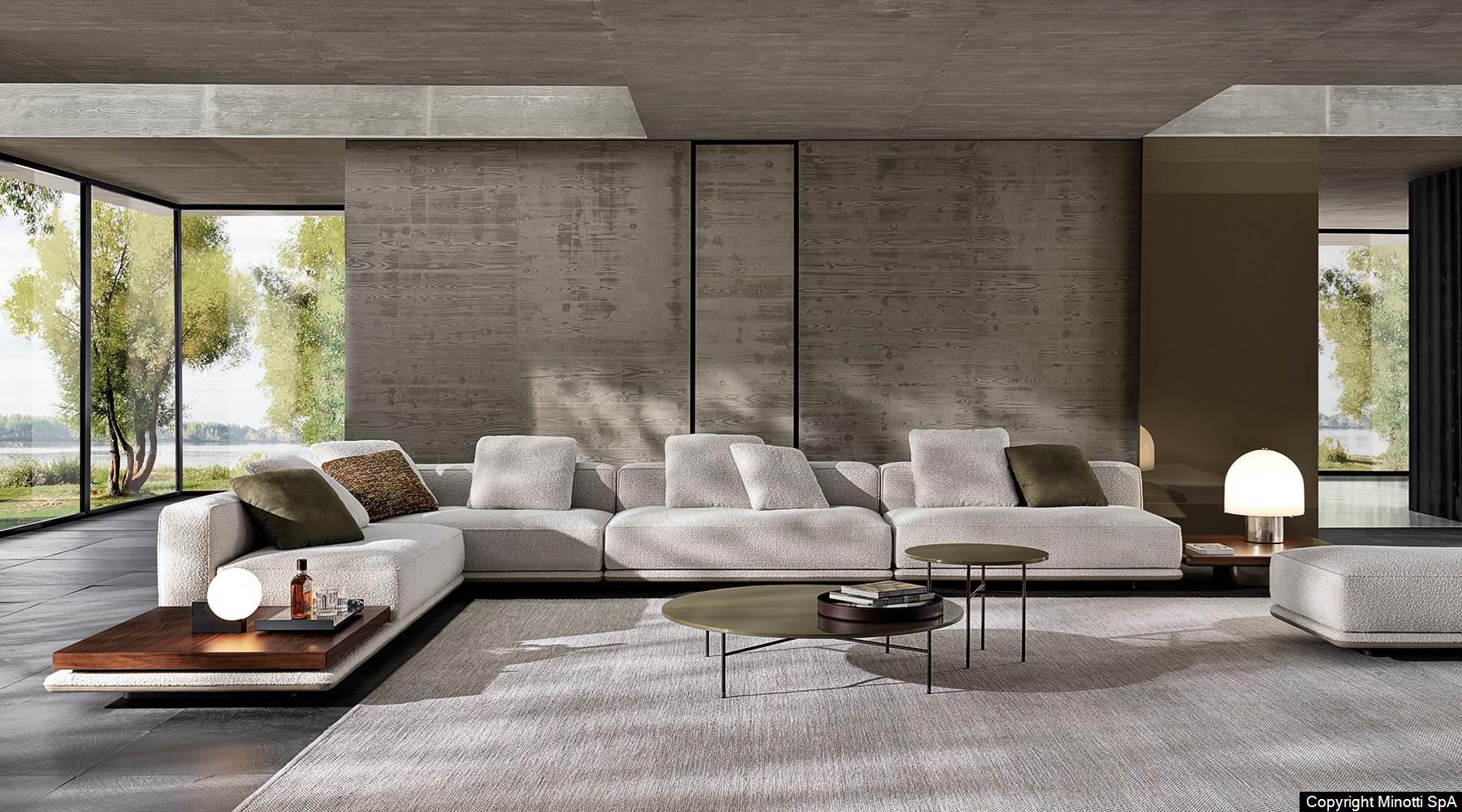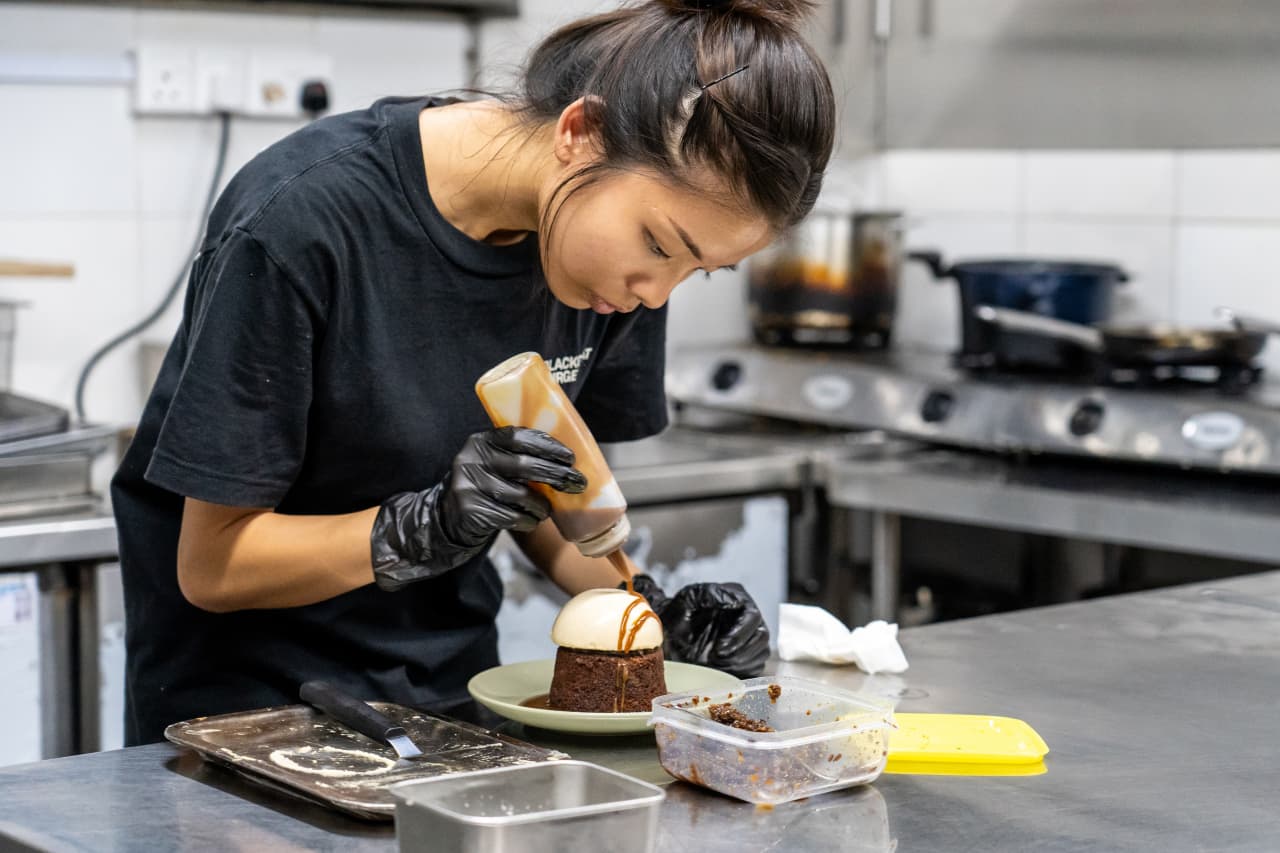10 Best Sofas That Will Elevate Your Living Room
Think of home, and think of…the couch. Family is important, sure, but a couch? That spells relax with a capital Lax. Sometimes outrageously expensive, sometimes surprisingly affordable. Check out are our top 10 sofas where you are sure to find the one that speaks your lounging language.
Atelier Sofa

The gorgeous, curvaceous Atelier from Coco Republic is coolly romantic in the way it wraps around you. Curves are so relaxing, and when they look this chic you’d expect to find it in an apartment on Haussman. The textures on offer are very on trend, and the optional pillows elevate the designer concept to true European elegance.
Barret Leather
Putting your feet up is never easier than with a little electrical assistance – take the Barret Leather sofa from Freedom Furniture. A strong piece from a design point of view, with leather stitched to perfection, and available in an amazing range of colours. It just needs a little extra space to lay on down.
Wilkes Modular

For a home that salutes colour and energy, you could not miss trying out the Wilkes Modular by Herman Miller. A mid-century style that is at once light on its legs, while packing a huge post-modern punch. Walking in the door and seeing this in your apartment, well, you’d be so happy to be home.
Horizonte

Described as a ‘floating island with square lines’ the Horizonte from Marcio Kogan/Studio mk27 is a sophisticated take on lounge furniture. It really does appear to float, the idea extending to the sympatico customisation of a built-in coffee table extension. This is James Bond suave. You could see it fitting like a glove into an ultra-modern minimalist, or eccentric maximalist décor.
Jasper
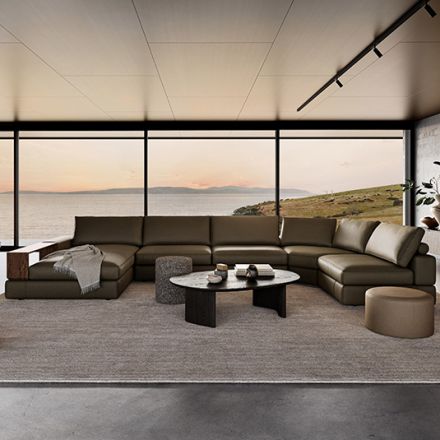
The flagship design of the King Furniture line, the Jasper is perhaps the father of all modular design. In a range of sizes, the familiar timber armrest-tables look as clever as ever, and now they offer even more ‘add ons’ such as a wireless charging table. Cool. Very deep, very springy, they have lasted this long because they fit into every lifestyle from beach house to townhouse.
Finlay

Not everyone can afford the moon when it comes to sofas – but do not be discouraged. Fantastic Furniture has a really smart looking three seater with chaise that has ‘pulled in’ seat stitching, which adds interest, and a choice of timber or metal legs. Easy on the eye and the pocket, it is a non-precious, relaxed sofa solution.
Mateo

Rarely does one want to see something ageing – but the simple, dramatic lines of the leather Mateo sofa from Coco Republic are only going to look more beautiful in 10 years’ time. This is a confident design, with generous stuffing – especially on the arms – it would be a perfect one to fall asleep on while bingeing on Netflix. Pewter or Taupe colours – both richly rewarding.
Lexington
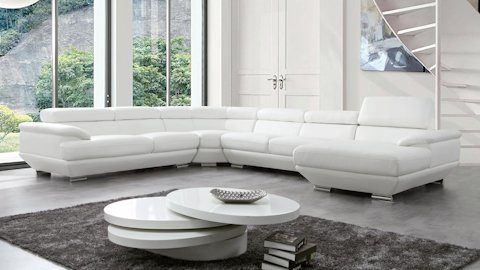
Ultra-modern is the best way to describe the angular, unique silhouette of the Lounge Life’s Lexington. One of the few sofas available that uses its mass to advantage, making a rather monumental statement. It has windswept arm rests too – perfect for lying back doing Wordle while the news is on. Combined with the adjustable headrests, this is multi-option sofa available in fabric or leather.
Lucia Cane
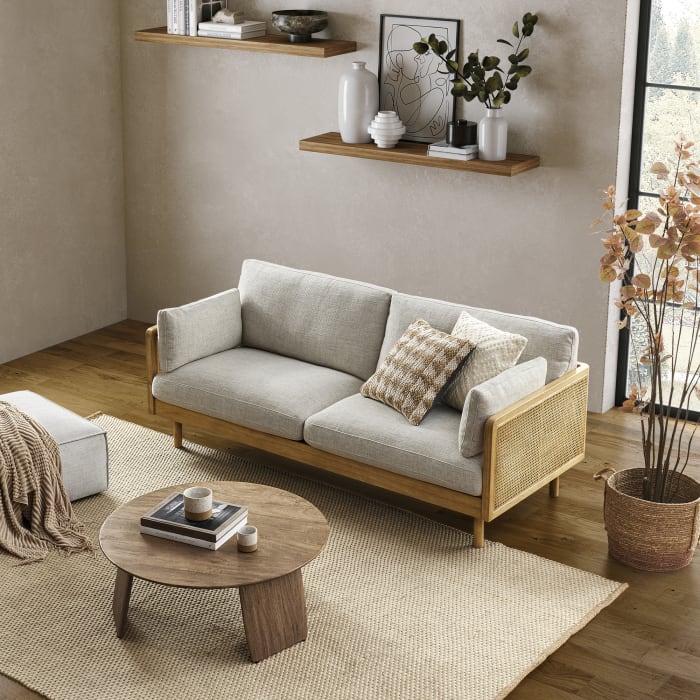
The cane detailing (which wraps around the entire piece) in the Castlery Lucia Cane sofa adds so much character that the piece just has to become a focal point in any room. The combination of the cane with the black detailing gives it an organic, breezy kind of vibe; with the potential to enhance an Asian themed or beach house décor. If you’re looking for something different, yet stylish, it’s a definite go-to.
Getaway Sofa
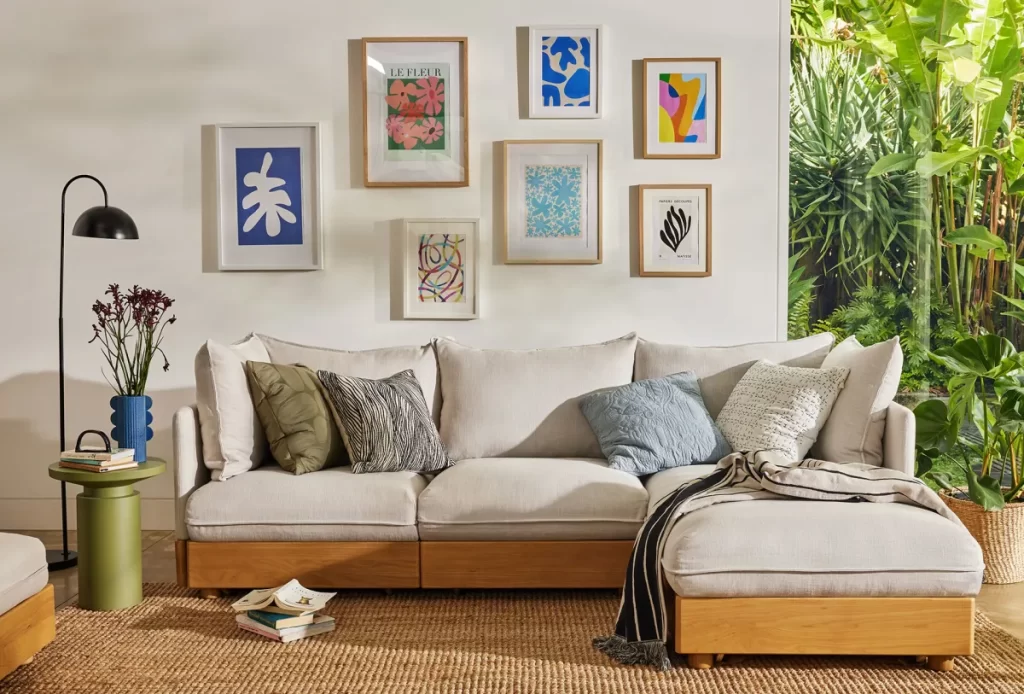
Here’s a sofa that says family, friends, dogs and cats. In short, it says relax and have fun. From Aussie brand Koala, the five to seven seater looks at its absolute best in gum tree green, as the timber feature panels (which are actually storage drawers) and matching feet just work so well with the forest theme. Big robust fluffy cushions, and a huge ottoman on offer, this is the one for those who just love to plonk down and chill out.
How can you tell if a sofa is good quality?
In a word: framing. A good quality frame will ensure your sofa will not only provide comfort but will last for 10 years or more. While solid timber framing is standard, there is also steel framing available. Don’t be afraid to ask to lift the sofa to give you an idea of weight, which is an indication of the quality of the framing.
What is the average price for a good quality sofa?
Everyone’s budget is different and you can certainly get excellent value for money in the secondhand sofa market. For new sofas, expect to pay upwards of $4000 to $5000 for a good quality modular sofa and $2,000+ for a two or three-seater that is made to last.
What sofas are the most durable?
If you’re talking about upholstery, it’s leather all the way. Easy to wipe down and able to take the hard knocks, leather sofas tend to age better than fabric sofas, making them ideal for family environments. For framing, solid timber or steel frames last extremely well. When purchasing, talk to your retailer about reupholstery services when the time comes. It’s a good indication of whether they are prepared to stand behind their product over time.
What are the best quality sofas to buy?
This is totally subjective and will depend on what you value, and how much you can budget for. Perhaps the easiest way to seek high quality is to ask about warranties. Look for sofas that have at least a 10-year warranty. In terms of coverings, genuine leather and natural fabrics such as linen and cotton offer a superior look and feel.
What should you look for when choosing a sofa?
Beyond choosing the right framing and fabrics for your sofa, shape and being fit for purpose is everything. If you have a family living space to fill, a modular sofa where everyone can spread out is ideal. For smaller apartment spaces, a pair of two-seater sofas might be a better option. Make sure you measure carefully, including the entranceways, before you buy.
This stylish family home combines a classic palette and finishes with a flexible floorplan
Just 55 minutes from Sydney, make this your creative getaway located in the majestic Hawkesbury region.
No trip to Singapore is complete without a meal (or 12) at its hawker centres, where stalls sell multicultural dishes from generations-old recipes. But rising costs and demographic change are threatening the beloved tradition.
In Singapore, it’s not unusual for total strangers to ask, “Have you eaten yet?” A greeting akin to “Good morning,” it invariably leads to follow-up questions. What did you eat? Where did you eat it? Was it good? Greeters reserve the right to judge your responses and offer advice, solicited or otherwise, on where you should eat next.
Locals will often joke that gastronomic opinions can make (and break) relationships and that eating is a national pastime. And why wouldn’t it be? In a nexus of colliding cultures—a place where Malays, Indians, Chinese and Europeans have brushed shoulders and shared meals for centuries—the mix of flavours coming out of kitchens in this country is enough to make you believe in world peace.
While Michelin stars spangle Singapore’s restaurant scene , to truly understand the city’s relationship with food, you have to venture to the hawker centres. A core aspect of daily life, hawker centres sprang up in numbers during the 1970s, built by authorities looking to sanitise and formalise the city’s street-food scene. Today, 121 government-run hawker centres feature food stalls that specialise in dishes from the country’s various ethnic groups. In one of the world’s most expensive cities, hawker dishes are shockingly cheap: A full meal can cost as little as $3.
Over the course of many visits to Singapore, I’ve fallen in love with these places—and with the scavenger hunts to find meals I’ll never forget: delicate bowls of laksa noodle soup, where brisk lashes of heat interrupt addictive swirls of umami; impossibly flaky roti prata dipped in curry; the beautiful simplicity of an immaculately roasted duck leg. In a futuristic and at times sterile city, hawker centres throw back to the past and offer a rare glimpse of something human in scale. To an outsider like me, sitting at a table amid the din of the lunch-hour rush can feel like glimpsing the city’s soul through all the concrete and glitz.
So I’ve been alarmed in recent years to hear about the supposed demise of hawker centres. Would-be hawkers have to bid for stalls from the government, and rents are climbing . An upwardly mobile generation doesn’t want to take over from their parents. On a recent trip to Singapore, I enlisted my brother, who lives there, and as we ate our way across the city, we searched for signs of life—and hopefully a peek into what the future holds.
At Amoy Street Food Centre, near the central business district, 32-year-old Kai Jin Thng has done the math. To turn a profit at his stall, Jin’s Noodle , he says, he has to churn out at least 150 $4 bowls of kolo mee , a Malaysian dish featuring savoury pork over a bed of springy noodles, in 120 minutes of lunch service. With his sister as sous-chef, he slings the bowls with frenetic focus.
Thng dropped out of school as a teenager to work in his father’s stall selling wonton mee , a staple noodle dish, and is quick to say no when I ask if he wants his daughter to take over the stall one day.
“The tradition is fading and I believe that in the next 10 or 15 years, it’s only going to get worse,” Thng said. “The new generation prefers to put on their tie and their white collar—nobody really wants to get their hands dirty.”
In 2020, the National Environment Agency , which oversees hawker centres, put the median age of hawkers at 60. When I did encounter younger people like Thng in the trade, I found they persevered out of stubbornness, a desire to innovate on a deep-seated tradition—or some combination of both.
Later that afternoon, looking for a momentary reprieve from Singapore’s crushing humidity, we ducked into Market Street Hawker Centre and bought juice made from fresh calamansi, a small citrus fruit.
Jamilah Beevi, 29, was working the shop with her father, who, at 64, has been a hawker since he was 12. “I originally stepped in out of filial duty,” she said. “But I find it to be really fulfilling work…I see it as a generational shop, so I don’t want to let that die.” When I asked her father when he’d retire, he confidently said he’d hang up his apron next year. “He’s been saying that for many years,” Beevi said, laughing.
More than one Singaporean told me that to truly appreciate what’s at stake in the hawker tradition’s threatened collapse, I’d need to leave the neighbourhoods where most tourists spend their time, and venture to the Heartland, the residential communities outside the central business district. There, hawker centres, often combined with markets, are strategically located near dense housing developments, where they cater to the 77% of Singaporeans who live in government-subsidised apartments.
We ate laksa from a stall at Ghim Moh Market and Food Centre, where families enjoyed their Sunday. At Redhill Food Centre, a similar chorus of chattering voices and clattering cutlery filled the space, as diners lined up for prawn noodles and chicken rice. Near our table, a couple hungrily unwrapped a package of durian, a coveted fruit banned from public transportation and some hotels for its strong aroma. It all seemed like business as usual.
Then we went to Blackgoat . Tucked in a corner of the Jalan Batu housing development, Blackgoat doesn’t look like an average hawker operation. An unusually large staff of six swirled around a stall where Fikri Amin Bin Rohaimi, 24, presided over a fiery grill and a seriously ambitious menu. A veteran of the three-Michelin-star Zén , Rohaimi started selling burgers from his apartment kitchen in 2019, before opening a hawker stall last year. We ordered everything on the menu and enjoyed a feast that would astound had it come out of a fully equipped restaurant kitchen; that it was all made in a 130-square-foot space seemed miraculous.
Mussels swam in a mushroom broth, spiked with Thai basil and chives. Huge, tender tiger prawns were grilled to perfection and smothered in toasted garlic and olive oil. Lamb was coated in a whisper of Sichuan peppercorns; Wagyu beef, in a homemade makrut-lime sauce. Then Ethel Yam, Blackgoat’s pastry chef prepared a date pudding with a mushroom semifreddo and a panna cotta drizzled in chamomile syrup. A group of elderly residents from the nearby towers watched, while sipping tiny glasses of Tiger beer.
Since opening his stall, Rohaimi told me, he’s seen his food referred to as “restaurant-level hawker food,” a categorisation he rejects, feeling it discounts what’s possible at a hawker centre. “If you eat hawker food, you know that it can often be much better than anything at a restaurant.”
He wants to open a restaurant eventually—or, leveraging his in-progress biomedical engineering degree, a food lab. But he sees the modern hawker centre not just as a steppingstone, but a place to experiment. “Because you only have to manage so many things, unlike at a restaurant, a hawker stall right now gives us a kind of limitlessness to try new things,” he said.
Using high-grade Australian beef and employing a whole staff, Rohaimi must charge more than typical hawker stalls, though his food, around $12 per 100 grams of steak, still costs far less than high-end restaurant fare. He’s found that people will pay for quality, he says, even if he first has to convince them to try the food.
At Yishun Park Hawker Centre (now temporarily closed for renovations), Nurl Asyraffie, 33, has encountered a similar dynamic since he started Kerabu by Arang , a stall specialising in “modern Malay food.” The day we came, he was selling ayam percik , a grilled chicken leg smothered in a bewitching turmeric-based marinade. As we ate, a hawker from another stall came over to inquire how much we’d paid. When we said around $10 a plate, she looked skeptical: “At least it’s a lot of food.”
Asyraffie, who opened the stall after a spell in private dining and at big-name restaurants in the region, says he’s used to dubious reactions. “I think the way you get people’s trust is you need to deliver,” he said. “Singapore is a melting pot; we’re used to trying new things, and we will pay for food we think is worth it.” He says a lot of the same older “uncles” who gawked at his prices, are now regulars. “New hawkers like me can fill a gap in the market, slightly higher than your chicken rice, but lower than a restaurant.”
But economics is only half the battle for a new generation of hawkers, says Seng Wun Song, a 64-year-old, semiretired economist who delves into the inner workings of Singapore’s food-and-beverage industry as a hobby. He thinks locals and tourists who come to hawker centers to look for “authentic” Singaporean food need to rethink what that amorphous catchall word really means. What people consider “heritage food,” he explains, is a mix of Malay, Chinese, Indian and European dishes that emerged from the country’s founding. “But Singapore is a trading hub where people come and go, and heritage moves and changes. Hawker food isn’t dying; it’s evolving so that it doesn’t die.”
This stylish family home combines a classic palette and finishes with a flexible floorplan
Just 55 minutes from Sydney, make this your creative getaway located in the majestic Hawkesbury region.









